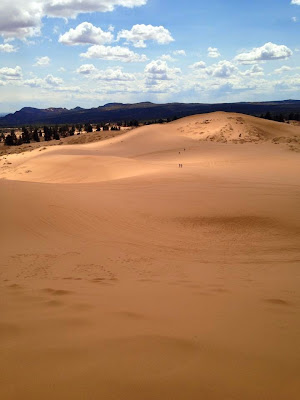Las Vegas was certainly not what I had expected, nor what I
had packed for. TV programmes and films had let me presume that Vegas was this
hot, dry place. Instead, we’ve landed in the middle of an extremely windy and
dusty place, in the midst of a sandstorm. The sandstorm had certainly made the
final moments of our long travel very interesting, and nauseating for that
matter, yet it was an apparent reminder of just how different and harsh the
environment can be ‘out west’.
(Photo courtesy of Alasdair Spark - This is the sandstorm we arrived in, the view is from the airport over 'The Strip'.)
The second of our two flights allowed me to see the mixed
scenery below. We left the metropolitan surrounding of New York City to fly
over field after empty field, with nothing but unoccupied land stretching for
miles. Dry and dusty landscapes topped with snow-capped mountains passed below
us, before we were finally able to set our eyes upon Las Vegas. It surprised me
desolate the city looks, a cluster of buildings in the middle of nowhere. Las
Vegas is in close proximity to nothing else of interest, allowing for the idea
of “what happens in Vegas, stays in Vegas” to become a reality.
(The view from the plane window was fly from New York City to Las Vegas - field after field)
Even in my half-asleep state, I am fully aware of how small
I feel in comparison to the glory of Las Vegas. Driving into the city felt like
driving into another world, everything is here for your convenience, food,
entertainment and designer goods galore - and it’s yours for the taking if you
have the money for it. I’m apprehensive about what Vegas is about to throw at
me, and slightly afraid that I won’t be able to keep up with the type of
lifestyle Vegas expects you to have to belong here.













































